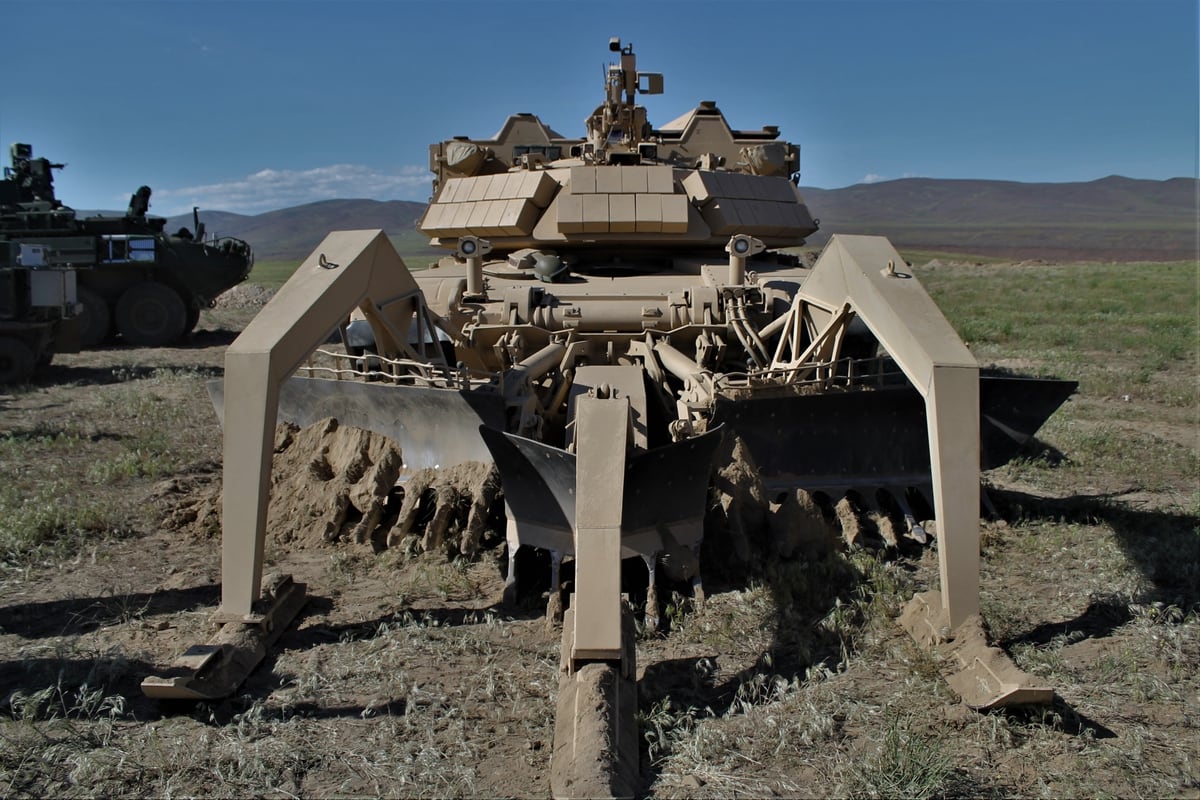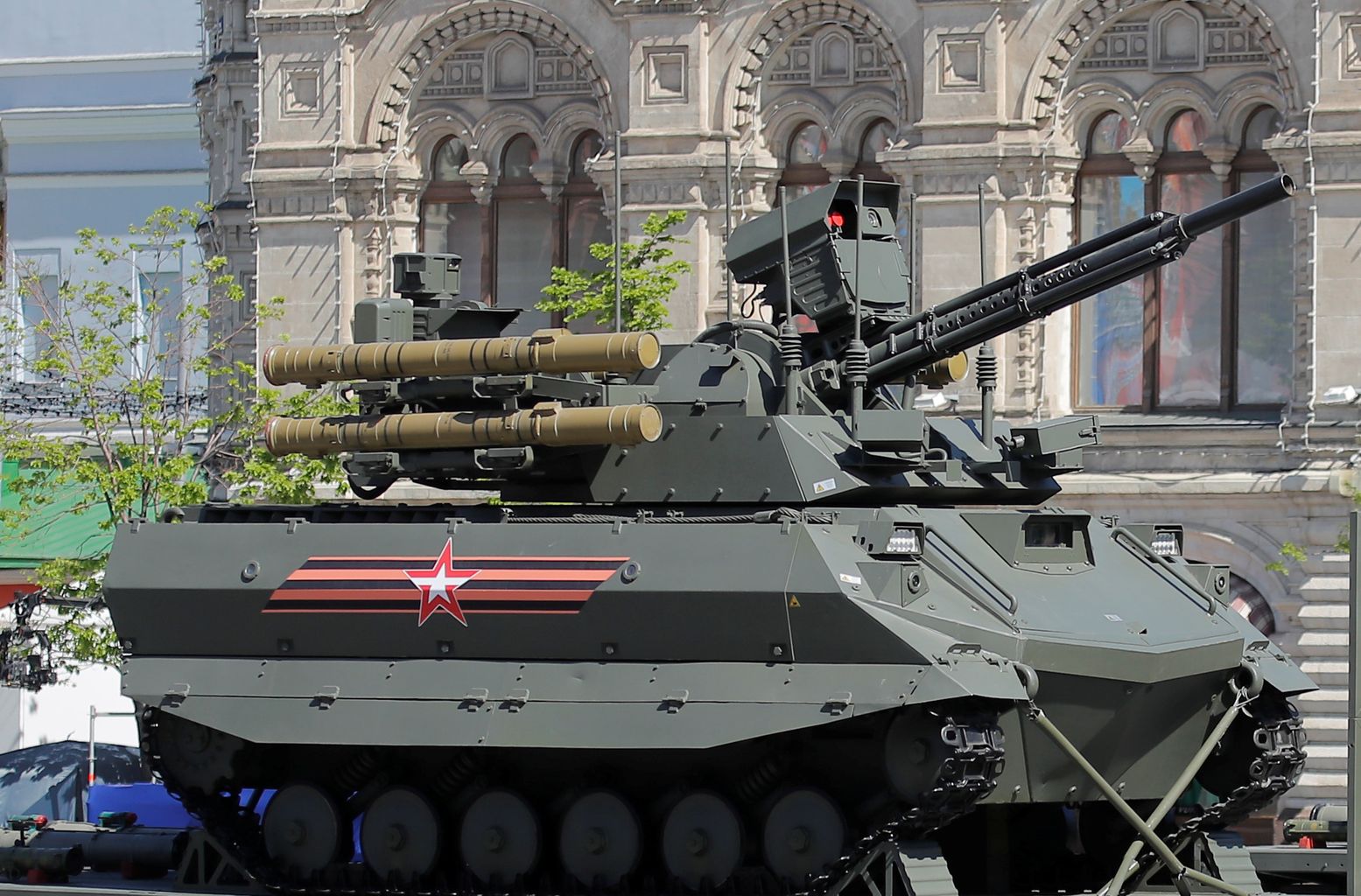Dirty Work: Robots take on complex breach as Army evaluates potential
By: Jen Judson
10 May 2019
An up close look at a robotic Assault Breacher Vehicle which cleared mines during a combined arms breach exercise at Yakima Training Center in Washington State May 7. (Photo by Jen Judson/Defense News staff)
YAKIMA TRAINING CENTER, Wash. — The Army conducted an elaborate robotic combined arms breach exercise at Yakima Air Base in Washington State this month to figure out how robots can best take on the dangerous and dirty work and the technology, tactics, techniques and procedures that are
needed for unmanned vehicles to be effective on the battlefield.
Gen. Mike Murray, the Army Futures Command commander, landed via UH-60 Black Hawk on a high desert plateau at Yakima Training Center, May 7, with a University of Texas engineer in tow who specializes in robotics, to check out the progress made by the 2nd Battalion, 3rd Infantry Regiment of the 1st Brigade, 2nd Infantry Division Stryker Brigade Combat Team, led by Lt. Col. Jonathan Fursman, in assessing robotic breach capabilities as part of Bayonet Focus and the Joint Warfighting Assessment 2019.
JWA is an annual exercise meant for experimentation of new and emerging concepts and capabilities. It has been held at Fort Bliss, Texas, and in Germany. This year it is back stateside but the plan is to return to Europe in 2020.
“We never, ever want to send another soldier into a breach, so how do we do this completely autonomously,” Murray said, adding this is the problem set he’s laid out for engineers and for the Army to try to figure out.
Murray’s command is less than a year old, but it has hit the ground running to carry out it’s mission to rapidly modernize the Army with a focus on six priorities: Long-Range Precision Fires, Next-Generation Combat Vehicle (NGCV), Future Vertical Lift (FVL), the Network, Air-and-Missile Defense and Soldier Lethality.
Within the NGCV portfolio, the Army will
evaluate and prototype robotic combat vehicles,but, according to Murray, the technology isn’t the challenge, it’s figuring out the utility of robots and how they can best be used on the battlefield, which means understanding shortcomings and advantages of the technology.
“It’s not necessarily the hardware, it’s about the employment of robotics and the human-robotics interfaces that we have to look at,” Murray told Defense News, who accompanied him on the trip.
The Army continues to introduce complexity to its breach exercises, adding more layers to this year’s evaluation over last year’s at the JWA 18 in Germany to include flying a Black Hawk helicopter overhead that spits out two unmanned aircraft systems — called Air-Launched Effects or ALE — thousands of feet above the earth to perform surveillance and reconnaissance of enemy terrain. That capability is in its infancy but is part of the FVL modernization efforts underway.
“The robotics piece of this is not the hard part,” Murray said. “The hard part is figuring out where it makes sense, how they interact, how they adapt, how soldiers do certain things now that they have robotic capability.
“There are a lot of things we have to work through,” he said.
Fursman, as well as Captain Nichole Rotte, commander of Bravo Company, 23rd Brigade Engineer Battalion, were tasked to design the breach obstacles and how robots might overcome them, but also to think about how to challenge those robots in a complex and realistic scenario.
Robots don’t get to just roll up to enemy-arranged obstacles on a real battlefield and bust through them without a fight, so Bravo Company took on the challenge of figuring how robots can be useful breaching obstacles like mine fields, concertina wire and anti-tank trenches while under fire in order to clear the way for an assault into enemy territory.
The Army has come a long way, even in just the past few years. In 2017, at Fort Benning, Georgia, the Maneuver Center of Excellence held a
demonstration of robotic combat vehicle capability, showcasing its efforts to develop a robotic wingman within the maneuver force and how to incorporate robotic capability within a tank formation, but the demonstration lacked a complex operational scenario and difficult obstacles for the robots to overcome.
The breach exercise at Yakima challenged a wide array of robots with an obstacle layered with mine fields, wire and a deep trench.
In addition to surveillance from the ALE, the Alabama National Guard launched a Chemical, Biological, Radiological and Nuclear (CBRN) quad-copter from a reconnaissance vehicle to assess any chemical agents used in creating obstacles as well as a Puma UAS to also check out the obstacles ahead of sending in robotic vehicles.
And the unit deployed a smoke screen using a robotic Polaris MRZR with the capability of maintaining a thick and steady plume for roughly 30 minutes.
To conduct the actual breach, Rotte’s unit used two surrogate NGCVs to secure the area and provide suppression fire — a Humvee and an M113 armored personnel carrier both equipped with a 7.62 machine gun. The Humvee was controlled by another Humvee and the M113 was controlled by an operator in a Stryker both maintaining line-of-sight, positioned in low ground beneath the plateau.
With the enemy suppressed, two robotic assault breacher vehicles controlled by a Marine Corps unit began to tackle the obstacles. Both robotic vehicles were controlled from a single command vehicle.
The first ABV employed a mine clearing line charge and then cleared a path for the second ABV, inserting stakes in the ground as it moved forward to mark where it was safe for the second ABV to drive through with a blade to tackle filling in the tank trench.
Once the ABV was able to fill in the ditch, it drove through, paving the way for an assault force to move in on the enemy location.
The first time the breach exercise was conducted, the entire operation took two-and-a-half hours, according to Rotte, but the second time around the operators were able to shave off 30 minutes and proved that robotics can accomplish the same breach over roughly the same time as a manned operation would.
The units conducting the breach are already taking away lessons learned and thinking about questions raised through the employment of robotics on a complex battlefield.
Sticking out like a sore thumb
One of the bigger issues is the electronic signature given off by a group of robots on a battlefield so the Army took the opportunity to assess the implications of that reality during the robotic breach exercise.
“I worry about the links in terms of it being secure,” Murray said. There are lots of things we gotta work through.”
Fursman said a lot of thinking went into how to obscure the robotic activity, which was largely achieved through a physical smoke screen, but also electronically.
“This is a robotic breach, so you are going to have electronic signatures, so jamming is a threat for example,” Fursman said.
The exercise included a mounted and dismounted electronic warfare capability used to detect enemy locations in order to deploy anti-tank round equipped Single Multipurpose Attack Munitions (SMAMs) — also known as Kamikaze drones — onto targets. The capability was also used to jam enemy frequencies.
But even with those capabilities, the noisy signatures of robotics and the capability of the enemy to jam them is a cause for concern, Fursman noted.
So the unit tried to deceive the enemy forces by emitting a larger signature on the far side of the plateau to make it look like it was massing in another location through a lot of radio traffic and other signatures, Fursman said.
This would work if the enemy could only see the force electronically, Fursman said. “They’d see a much bigger signature over here, while we were tucked in behind terrain here waiting to begin the operation.”
But once the enemy has eyes on the robots conducting the breach, “the last thing I’m worried about is electronic signature,” Murray added.
What if an 80-ton robot dies in a ditch?
A less than ideal scenario would be for an 80-ton robot filling in a trench, for instance, to go down in the middle of breaching the obstacle.
And so the Army is wrestling with what happens when a breach vehicle is taken out. “Can you just bring in another one,” Murray said, mulling over the scenario, “you can’t. You only have one lane, you are not going to push it out of the way, so you are starting a new breach lane if that happens.”
Rotte said she and her unit are thinking about solutions. “How do I push it through the breach? How do I recover it? What’s the next step,” she said.
“We have come up with a couple of TTPs if we lose the robotics or if something happens,” like bringing in operators via Stryker to move the trucks manually through a breach, Rotte added. “But are there other options?”
One idea, she noted, might be to send in more expendable vehicles that are easier to push out of the way and leave on the battlefield.
Murray brainstormed the use of smaller vehicles to perform certain tasks like detonating mines, or perhaps using 1113s. “We’ve got thousands and thousands of 113s that we could make robotic and that are completely expendable,” he said. “The more you can get to expendable assets to do this the better off you are going to be.”
The robotic breach also triggers the debate over what the Army should procure in the future and how those capabilities should be deployed.
Should the Army send in high-tech, expensive, and heavily armored optionally manned vehicles to conduct operations like breaches or can the service design robotic vehicles “that are a little bit more skeleton with all the breaching equipment so if it doesn’t make it, it doesn’t make it, and you just buy more for the redundancy factor,” Rotte said.
How much autonomy is ideal?
All of the vehicles used in the breach were robotic, controlled by soldiers in the backs of manned vehicles staying back out of harm’s way.
For most of the soldiers operating the robots, training began just three short weeks prior. Most operators said they were proficient in less than a few days.
One of the ways that made learning easy was because the Army designed the control systems for the robots with Xbox controllers, with which many soldiers are instantly familiar.
Operators did say there is still latency when it comes to the sensor and video feeds from cameras on the robots but it was barely an issue.
And the robots were not particularly difficult to maneuver, while there are still some issues to work through, according to the operators.
But Rotte’s team did mull the level of autonomy that might be appropriate to take some of the burden off of manned crews staying back, but for the purpose of the breach exercise, operators stayed entirely in the loop.
The Army will continue to add complexity in robotic operational exercises, according to Murray, as it figures out how to adopt capability into a modernized force either through applications in the current fleet or in future vehicles.
Learning by doing, the Army is assessing how robots can be an asset on the battlefield.

www.defensenews.com










